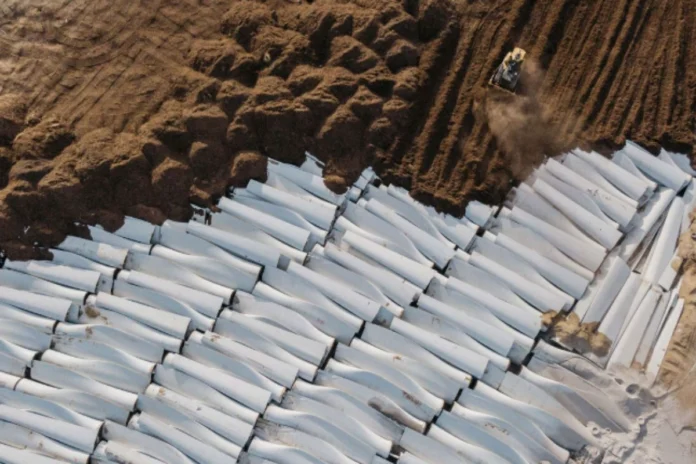Wind Turbine Blades Waste: When a wind turbine’s blades reach the end of their useful life, they cannot simply be removed because they can be longer than the wings of a Boeing 747. Initially, you must use an industrial saw coated in diamonds to cut the brittle fibre glass into three pieces that are tiny enough to be fastened to a tractor-trailer.
Tens of Thousands of Blades Requiring Disposal
The last resting place of 870 blades whose days of producing renewable energy have come to an end at the municipal dump in Casper, Wyoming. The broken pieces resemble bleached whale bones pressed together. Landfills are the only destination for the majority of the tens of thousands of old blades that are falling from steel towers all over the world. Over the course of the next four years, around 8,000 will be removed in the United States alone.
In 2020 BloombergNEF claim that, roughly 3,800 people will be leaving Europe each year through at least 2022, as the continent has been coping with the issue for a longer time. The majority were constructed more than ten years ago, when installations accounted for less than 5% of what they are today, so things will only get worse.
Hurricane-Resistant Blades
Because they are made to resist hurricane-force winds, the blades are difficult to crush, recycle, or use for other purposes. This has prompted a desperate quest for substitutes in areas devoid of expansive grasslands. In the United States, they are disposed of in a few landfills near Lake Mills, Iowa; Sioux Falls, South Dakota; and Casper, where they are buried in stacks that are up to thirty feet below the surface.
Clean Energy Commitments
Many governments and corporations have committed to switching to clean energy by 2050 in order to stop the disastrous climate change that is caused by burning fossil fuels. One of the least expensive ways to accomplish that is via wind energy.
Generators are turned by turbines to produce electricity. Following the Arab oil embargo of 1973, when shortages forced western governments to discover alternatives to fossil fuels, modern models came into being. In 1980, New Hampshire became the site of the country’s first wind farm, and thousands of turbines were placed by California east of San Francisco, over the Altamont Pass.
Early Models and Congressional Boost
The early models spun quickly and low, were costly, and inefficient. Following Congress’s 1992 tax credit passage, manufacturers made investments in larger and more potent designs. Their fibreglass blades swung freely from their 260-foot-tall steel tubes. Ten years later, General Electric Co. established an industry standard with its 1.5 megawatt model, which could power 1,200 households in a strong wind.
85% Recycling Rate for Parts
About 85% of turbine parts, such as steel, copper wire, electronics, and gears, may be recycled or reused, making wind power a carbon-free energy source. However, getting rid of the fibreglass blades is still challenging. Big rigs can only carry one at a time, and some of them are as long as a football field. This means that the expense of transportation for long-distance hauls is exorbitant. Researchers are working to develop more effective methods for separating fibres from resins or repurposing small pieces as boards or pellets.
Burning Blades in Cement Kilns and Power Plants
Certain blades are burned in cement-making kilns or power plants within the European Union, where landfill disposal regulations are very severe. However, the energy content of the burning fibreglass is uneven and poor, and contaminants are released. Wind farms at Casper, Wyoming, under the shade of a snow-capped mountain, symbolise the potential benefits and drawbacks of moving away from fossil fuels. The oil boomtown that went bust was established at the start of the 1800s.
Keep watching our YouTube Channel ‘DNP INDIA’. Also, please subscribe and follow us on FACEBOOK, INSTAGRAM, and TWITTER

